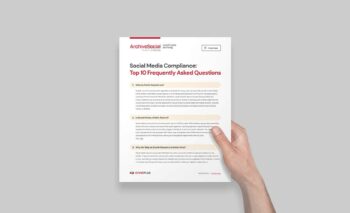7 Social Media Best Practices for Mass Transit in Special Districts
When used effectively, social media can be an invaluable tool for mass transit agencies. It can increase ridership, keep people informed of public transit changes, and improve overall satisfaction.
In 2022, the National Academies of Sciences, Engineering, and Medicine published a thorough report on the uses of social media in public transportation. It revealed that while many transit agencies are using social platforms to connect with riders — 83 percent on Facebook and X (formerly Twitter), 63 percent on YouTube and Instagram, and 53.2 percent on LinkedIn — they still might be missing out on best practices that can help meet their goals.
Let’s take a look at seven practices that your agency should be using to enhance its social media presence.
1. Have a Designated Social Media Role
Social media empowers transit agencies to connect with riders in a way that wasn’t possible in previous decades. However, social platforms require specialized knowledge and dedicated time. Without designating a social media manager who has the right experience and public relations skills, it’s difficult for any government agency to execute an effective social media strategy.
Employing someone dedicated solely to social media is ideal, but at the very least, make sure you’ve appointed one or more employees to manage your channels and respond to comments. Establishing clear roles and responsibilities for channel management is important for building trust with riders and responding to complaints and concerns with transparency.
2. Publish Important Updates
If your agency is currently using social media, think about any content you’ve posted in the past few months. Have you provided information about all the delays, service updates, and other events that impacted riders?
Often the first thing users look for when they visit your social pages is news and events relevant to their daily lives. In situations when you’re planning an event or preparing for a service disruption, plan posts proactively and send multiple reminders to increase awareness. In unforeseen circumstances or emergency situations, send frequent real-time updates to keep riders informed.
Related Read: Top Tips for Government Social Media Success
3. Prioritize Time Management
In addition to having dedicated social media staff and posting about updates and events that matter most to your ridership, it’s important to provide timely responses.
People turn to social media for real-time information and expect quick replies to their comments. When developing your social media strategy, set benchmarks for response times and have dedicated staff that can monitor social media responses after hours to make sure riders feel heard. Transparent two-way communication increases public trust, transparency, and rider satisfaction.
4. Align Social Media With Marketing Goals
Coordinating your social posts with marketing and communication plans is a best practice that helps increase awareness for your transit services.
By broadening your social media following and publishing cadence, you’re likely to increase ridership. Marketing your agency on social media can also be a way to attract potential employees and residents to your transit system.
5. Make Social Media Accessible
Many agencies find it challenging to meet digital accessibility goals. Only 29.8 percent of agencies’ social media websites are completely accessible for people with disabilities. Another 40.4 percent have partially accessible sites, and only 2.1 percent are in the process of making their sites accessible.
Just as accessibility for riders with physical disabilities is required by law on public transit, government agencies must make online content accessible for those who face barriers to reading, seeing, and understanding digital content. Web accessibility tools can help you ensure all riders can access up-to-date information on social media to stay informed about transit news that impacts them.
Related Read: The Department of Justice’s (DOJ’s) Latest Rule on Web Accessibility
6. Use Social Media Archiving Technology
Because social media used by government agencies is public record, you are required by law to maintain copies of social posts and comments, and provide them for public records requests. Despite this, 23.4 percent of transit agencies do not archive social media posts. The process can be time-consuming and difficult for transit agencies, especially special districts with limited resources.
As a best practice, use social media archiving software to effortlessly preserve all posts and comments — including hidden or deleted ones — in an easily searchable database. This saves invaluable time and effort for staff and helps maintain compliance.
Related Read: Grafton, WI, Discovers the Value of Social Media Archiving
7. Establish Social Media Policies and Best Practices
The rebranding of Twitter to X is the starkest reminder that the social media landscape is always changing and never predictable. The same can be said for teams and staff dedicated to mass transit social media. As people come and go and trends evolve, it’s important to establish and document your agency’s social media guidelines. With a formal policy, you can easily share best practices with new team members and stakeholders, and refer back to it to maintain consistency.
To get started, use a social media policy template. Once you’ve established standards for your agency such as time constraints, social media archiving technology, and others identified throughout this article, review and update on a regular basis. By ensuring your transit agency’s social media workflows are effective, sustainable, and compliant, you can open exciting possibilities for engaging with riders and improving trust and satisfaction for your agency.
Enhance Community Engagement with Effective Social Media Strategies
By following best practices for social media, transit agencies can increase the value of their social content and make managing it more efficient and compliant.
Effective social media use strengthens community relationships. It keeps riders informed and increases accessibility, creating a more responsive and inclusive public transit system. Social media is not just an extra step but an essential tool for helping residents navigate services and improving how community members reach their destinations. Learn more about CivicPlus’s Special Districts Product.


